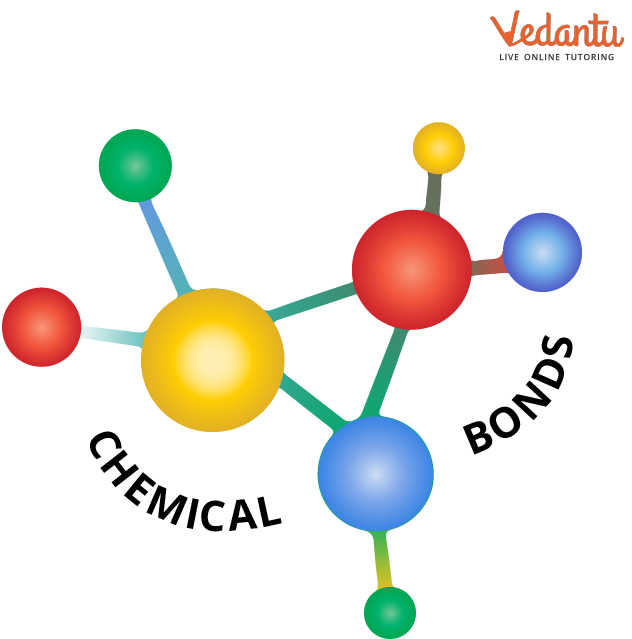




Introduction
You already know that all types of matter are made up of atoms, which explains the chemical bond definition. Everything around you is made up of atoms, including the food you eat, the water you drink, the pets, toys, and even your own body. Since there are such strong attraction forces between the atoms, these atoms naturally interact with other atoms via chemical bonds.
These atoms are so small that you need a microscope to see them. How can something so small as an atom help us? Like Lego blocks, these tiny atoms become useful when they join together. Now let us learn in detail about the chemical bond.

Chemical Bond
What is Chemical Bond?
The chemical bond definition: Chemical bonding is when two or more molecules, atoms, or ions come together to form a chemical compound. The atoms that make up the complex are held together by chemical bonds.
Atoms receive or lose electrons or trade them with other atoms to achieve a stable electronic configuration. As a result, the system's energy level drops to its lowest point and a chemical bond forms. Maximum stability is achieved in this way. A covalent bond forms when two atoms share electrons, whereas an ionic bond forms when one or both atoms lose or acquire an electron.
Types of Chemical Bonds
There are two different kinds of chemical bonds that can happen. Covalent bonds and ionic bonds are the names of these two types of bonds. Each of these types of bonding uses electrons in a different way to make sure that each atom has a full outer shell.
Covalent Bonding - Electrons are always shared between two atoms in pairs. Neither atom loses or gains an electron during this type of bonding. Instead, they share their electrons so that their outer shells are full.
Ionic Bonding - When atoms of one element give their electrons to atoms of another element so that both can have a full outer shell, this is called an ionic bond.
Chemical Bond With Examples

Understand the Chemical Bond Meaning with Chemical Bond Images
Below mentioned are the chemical bond examples: -
Let's look at some elements, like sodium and fluorine, to get a better idea of how chemical bonds work.
The outer shell of sodium (Na) only has one electron. Now, this sodium atom can do one of two things. It can give one of the electrons in its third shell to another atom and have two complete shells with 8 electrons in each orbit, or it can keep looking for a kind atom with extra electrons to meet it someday and fill up its third shell. Which one seems simpler to you? It has to be the first one! It is much easier for the atoms to give away their electrons than to keep waiting to get more.
The outer shell of the atom of another element, fluorine (F), has 7 electrons, so it is missing one electron to be "happy." So, these two atoms make themselves happy by giving and taking electrons from their outer shells. In other words, the sodium atom provides the fluorine with an extra electron in its outer shell.
After this, both atoms have 8 electrons in their outer shells. An ionic bond is a name for this type of bond. When an atom loses an electron, it gets a positive charge like sodium (Na+), and when it gains an electron, it receives a negative charge like fluorine (F-). Positive and negative charges attract each other like magnets, and this helps the bond form and stay together. These all can be easily findable in the chemical bonding worksheet.
Chemical Bonding Worksheet
The list of compounds with their chemical bonding between atoms of these compounds for 15 compounds are as follows:
Interesting Facts About Chemical Bonds
Facts that are interesting regarding chemical bonds:
Since noble gases have a naturally full shell, they rarely react.
Most of the time, ionic bonds are made between metals on the left side of the periodic table.
Atoms in molecules stick together because the nucleus and the electrons attract each other.
Summary
A chemical bond is a way for atoms, ions, or molecules to always pull toward each other. As in ionic compounds, bonding can happen when two ions with different charges are drawn to each other or when two atoms share electrons, as in covalent bonds. The strength of the chemical bonds is very different from one to the next. A "chemical bond" is the place where two atoms stick together.
FAQs on Facts About Chemical Bonds Explained in Detail
1. What is a chemical bond and why do atoms form them?
A chemical bond is an attraction between atoms that allows the formation of chemical substances. Atoms form these bonds to achieve a more stable, lower-energy state. This is typically accomplished by completing their outermost electron shell, often referred to as achieving a stable octet (eight valence electrons), similar to that of a noble gas.
2. What are the primary types of chemical bonds?
The three primary types of strong chemical bonds that hold atoms together within a molecule are:
- Ionic Bonds: Formed by the complete transfer of one or more electrons from a metal to a non-metal, creating oppositely charged ions that attract each other.
- Covalent Bonds: Formed when two non-metal atoms share one or more pairs of electrons to achieve stability.
- Metallic Bonds: Found in metals, where a 'sea' of delocalised electrons is shared among a lattice of positive metal ions.
Additionally, weaker forces called intermolecular forces, like hydrogen bonds, exist between molecules.
3. How does an ionic bond fundamentally differ from a covalent bond?
The fundamental difference lies in how electrons are used to achieve stability. In an ionic bond, there is a transfer of electrons between atoms with a large difference in electronegativity, resulting in charged ions (cations and anions) held together by electrostatic attraction. In a covalent bond, electrons are shared between atoms, typically with similar electronegativity. Essentially, it's the difference between 'giving/taking' electrons (ionic) versus 'sharing' electrons (covalent).
4. What are some common examples of compounds with ionic and covalent bonds?
Here are some common examples:
- Ionic Compounds: Common table salt (Sodium Chloride, NaCl) is a classic example, where sodium transfers an electron to chlorine. Other examples include Magnesium Oxide (MgO) and Calcium Chloride (CaCl₂).
- Covalent Compounds: Water (H₂O) is a key example, where oxygen shares electrons with two hydrogen atoms. Methane (CH₄), Carbon Dioxide (CO₂), and Ammonia (NH₃) are also covalently bonded molecules.
5. What factors determine the length and strength of a chemical bond?
Two main factors influence bond length and strength:
- Atomic Size: Larger atoms form longer and generally weaker bonds because their valence electrons are farther from the nucleus.
- Bond Order: This refers to the number of shared electron pairs between two atoms. A triple bond is stronger and shorter than a double bond, which is in turn stronger and shorter than a single bond between the same two atoms.
Generally, there is an inverse relationship: shorter bonds are typically stronger bonds.
6. How does the Octet Rule explain the formation of a molecule like water (H₂O)?
The Octet Rule is a key principle explaining why atoms bond. In a water molecule (H₂O):
- An oxygen atom has 6 valence electrons and needs 2 more to complete its octet.
- Each hydrogen atom has 1 valence electron and needs 1 more to complete its duet (a stable configuration for the first shell).
By forming two single covalent bonds, the oxygen atom shares one electron with each of the two hydrogen atoms. This allows the oxygen to achieve a stable octet (6 of its own + 1 from each H) and each hydrogen to achieve a stable duet (1 of its own + 1 from O), resulting in a stable H₂O molecule.
7. Can a molecule with polar bonds be nonpolar overall? Explain how.
Yes, a molecule can have polar bonds but be nonpolar overall. This happens when the molecule has a symmetrical shape that causes the individual bond dipoles to cancel each other out. A perfect example is Carbon Tetrachloride (CCl₄). Each C-Cl bond is polar because chlorine is more electronegative than carbon. However, the four C-Cl bonds are arranged symmetrically in a tetrahedral shape around the central carbon atom. This symmetry causes the individual pulls of the polar bonds to cancel out, resulting in a molecule with no net dipole moment, making it nonpolar.









